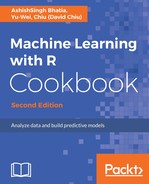In this recipe, we introduce another algorithm, Eclat, to perform frequent itemset generation. Though Apriori is a straightforward and easy to understand association mining method, the algorithm has the disadvantage of generating huge candidate sets and performs inefficiently in support counting, for it takes multiple scans of databases. In contrast to Apriori, Eclat uses equivalence classes, depth-first searches, and set intersections, which greatly improve the speed in support counting.
In Apriori, the algorithm uses a horizontal data layout to store transactions. On the other hand, Eclat uses a vertical data layout to store a list of transaction IDs (tid) for each item. Then, Eclat determines the support of any k+1-itemset by intersecting tid-lists of two k-itemsets. Lastly, Eclat utilizes frequent itemsets to generate association rules:

Similar to the recipe using the Apriori algorithm, we can use the eclat function to generate a frequent itemset with a given support (assume support = 2 in this case) and maximum length:

We can then use the summary function to obtain summary statistics, which include: most frequent items, itemset length distributions, summary of quality measures, and mining information. Finally, we can sort frequent itemsets by the support and inspect the top 10 support frequent itemsets.
